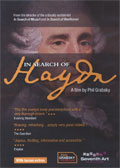
In Search of Haydn 2011
Distributed by Microcinema International/Microcinema DVD, 71 Stevenson St. Suite 400, San Francisco, CA 94105; 415-447-9750
Produced by Phil Grabsky
Directed by Phil Grabsky
DVD, color, 102 min.; 50 min. of extras; Mainly in English with subtitles where appropriate. Subtitles also available in French, German, Italian, Japanese, Mandarin and Spanish
Sr. High - General Adult
Music
Date Entered: 06/04/2012
Reviewed by Bonnie Jo Dopp, Librarian Emerita, University of MarylandFranz Joseph Haydn has never had a big commercial film devoted to his life. Grabsky’s effort may not become big, commercially, but it deserves generous applause from teachers aiming to focus students’ attention and appreciation on the composer credited with fathering the classical symphony (he wrote 104, many still in modern orchestra repertoires), mastering the difficult genre of the string quartet (68, more than 45 of them outstanding examples of the form), expanding the keyboard repertoire with numerous solo sonatas, and writing glorious oratorios that singers and audiences adore. Because Haydn was a fellow who presented himself as likable, stable (he stayed with one employer most of his working life), and “free of care,” his life story is far less dramatic than those of the ‘piece of work’ composers Mozart and Beethoven, subjects of Grabsky’s previous In Search of films. Perhaps the lack of outward distractions in the form of ‘life events’ in Haydn’s biography makes it easier to discover the man’s spirit (positive, creative, joyful, impish, experimental, dedicated, passionate, religious) in his music. By allowing articulate Haydn scholars and interpreters to provide helpful commentary on Haydn’s life (presented chronologically), personality, spirit, and methods, Grabsky seems indeed to have found the composer he was seeking.
As for Grabsky’s other composer films, Juliet Stevenson does a lovely job of narrating. Haydn scholars (such as David Wyn Jones, Richard Wigmore, and Tim Blanning) tell stories from his life and performers (including conductors Sir Roger Norrington and Ian Page, pianists Emanual Ax, Ronald Brautigam, and Marc-André Hamelin, string players, and singers, to list just a few) talk about and play the music. Appropriate choices of iconography enliven the narration, and visits to Haydn museums offer visual diversity to a film dominated by talking heads and musical hands (which Grabsky’s camera, as usual, intimately follows as they traverse keyboards, apply bows to strings, or conduct orchestras).
Haydn’s world of sound is contrasted with our own by pianists using either fortepianos or modern grands in their demonstrations, by the Orchestra of the Eighteenth Century sounding authentically of that time (everyone plays on period instruments or modern copies of them) and even acting out the Farewell Symphony, while Haydn string quartets are performed on modern string instruments, and by differences between the sound of Haydn-era keyed trumpets and modern valved trumpets being clearly outlined via enthusiastic reports from their players Jonathan Impett and Alison Balsom, both of whom play segments of Haydn’s trumpet concerto.
Henry Goodman does a fine job of speaking for historic figures, including Haydn himself. Phil Grabsky talks about making the film in a 25-minute extra segment. Another 25-minute extra features nine performances of full movements from the more than forty excerpts in the film.
This program deserves a spot in all DVD collections that own Grabsky’s Mozart and Beethoven films.